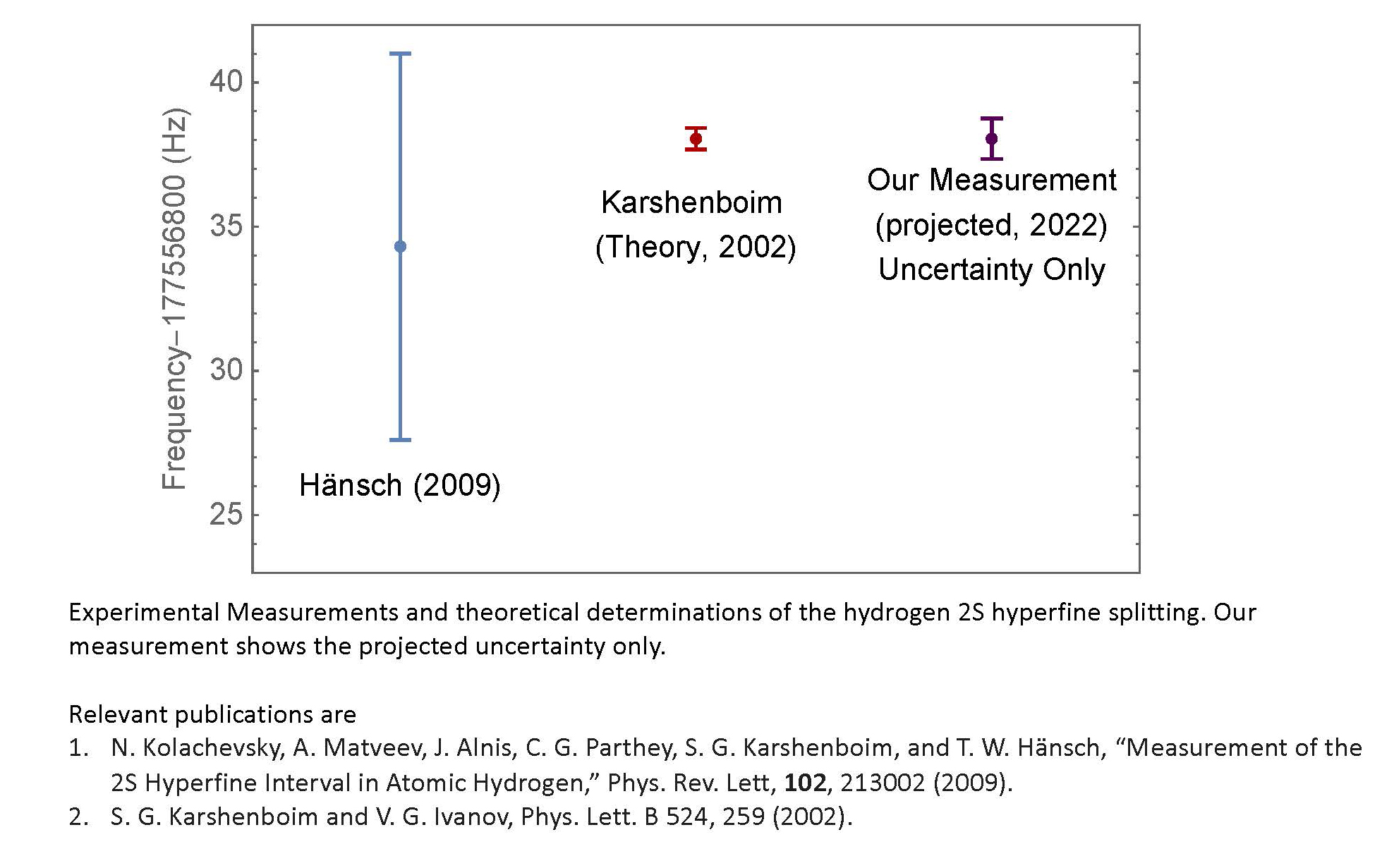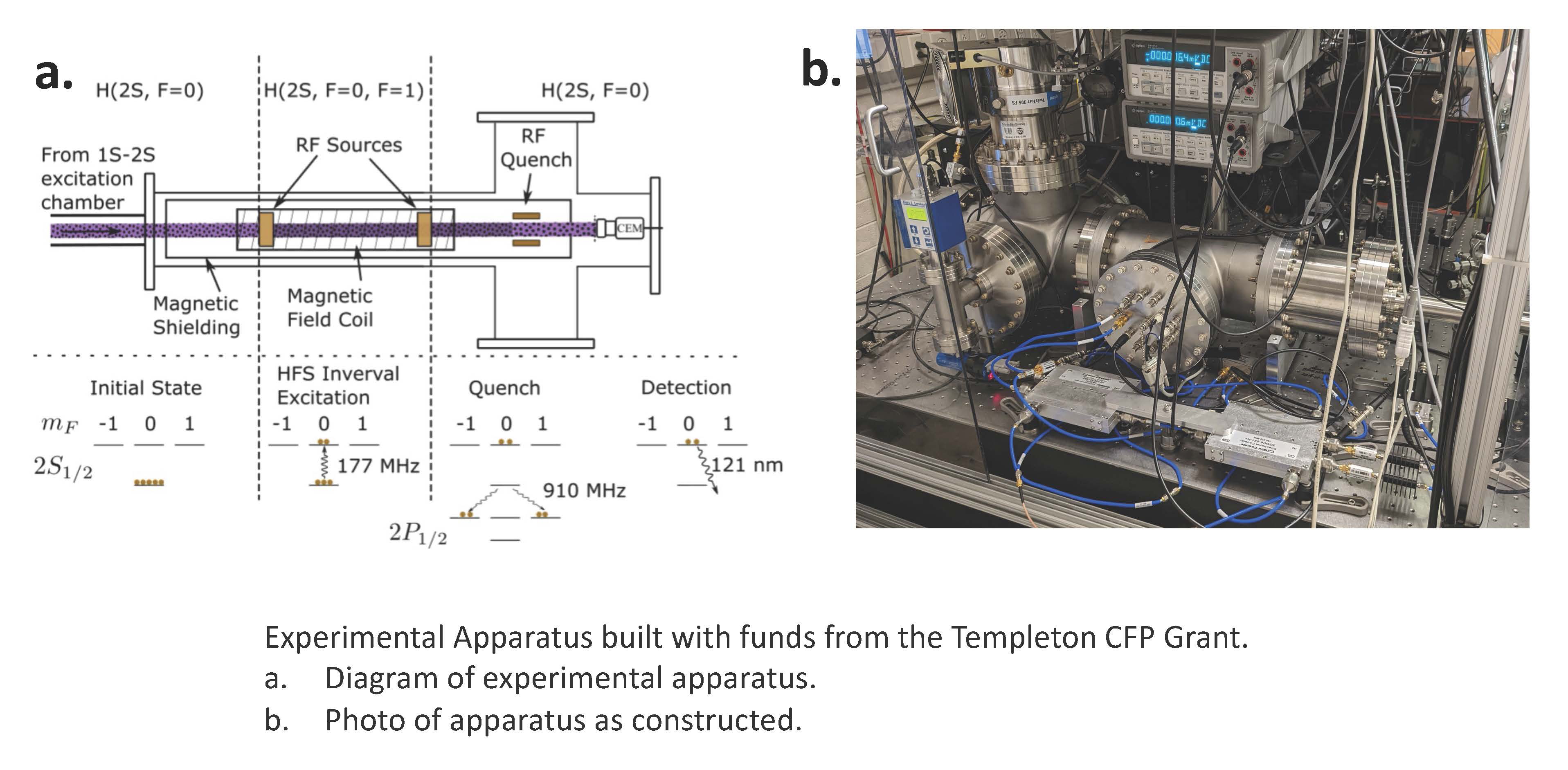Center for Fundamental Physics (CFP)
With Tabletop Experiments
Dylan Yost at Colorado State University
Search for Anomalous Spin-Dependent Forces through Hydrogen Spectroscopy


With funds from the CFP Templeton research grant, we have initiated a new experimental program to measure the hydrogen 2S hyperfine interval with a fractional uncertainty less than 4 × 10−9 (0.7 Hz), which is an order of magnitude smaller uncertainty over previous measurements. We have a long-term goal to reduce that uncertainty further to ∼ 1 × 10−10 (20 mHz), and to repeat these measurements in deuterium. Such measurements stringently test bound-state QED and could be used to search for previously undetected spin-dependent forces. Such forces, if found, would indicate new particles which could be dark matter candidates. For this experimental program, we have leveraged our cryogenic and velocity-characterized beam of 2S hydrogen that has been developed for other purposes. Currently, we achieve the target uncertainty in roughly an hour of data acquisition, and we are characterizing a few remaining systematic effects. We hope to have a first measurement completed by the end of 2022.
Ultimately, our goal in initiating this measurement is to search for physics beyond the Standard Model (BSM physics). A deviation of the experimental hydrogen hyperfine value from the theory could be an indication of an anomalous spin-dependent force. This in turn could be an indication of an axion– a dark matter candidate, which could also provide a solution to the strong-CP problem (an apparent fine-tuning in quantum chromodynamics so that CP symmetry is preserved). In addition to being an indication of axions, new spin-dependent forces are a feature of other BSM theories and could even be a feature of spontaneous Lorentz violation. Therefore, this measurement could contribute to several remaining big questions in physics.
While it is possible that the measurement proposed here could directly detect BSM physics, it is also possible that this experiment will instead provide a motivation and testing ground for new, higher-order bound-state QED contributions that have not yet been considered. As a result, the measurement could also support the detection of BSM physics in more exotic bound-state systems. As one example, we note that the fourth order QED corrections are similar for the muonium hyperfine structure, and this work may support the discovery of new physics in that system.
- Cory Rasor: Graduate Student (Cory graduated in the Fall of 2022 and the main work in his thesis was on the 2S hyperfine measurement funded exclusively by the CFP).
- Samuel Cooper: Graduate Student
- Ryan Bullis: Graduate Student
- Will Tavis: Graduate Student
- Scott Johnson: Undergraduate Student
- Dylan Yost: Faculty
The CFP Templeton grant initiated an entirely new research direction for our lab. We would not have pursued a hydrogen hyperfine measurement at all without these funds.
Specific scientific progress includes:
- We constructed the hyperfine spectrometer which mated onto our previous hydrogen beamline. This spectrometer consisted of a magnetically shielded interaction region with two RF coils to perform Ramsey spectroscopy, a quencher, and a metastable hydrogen detector.
- We conducted extensive RF characterization to ensure that we understood any minute phase shifts in our apparatus.
- We obtained preliminary line scans, characterized AC Stark shifts, and magnetic field shifts.
- We performed extensive modeling of our lineshapes and obtained preliminary velocity extrapolations to characterize the remaining small phase shift between our RF coils.
All the above was funded exclusively through the Templeton CFP grant.
Now that the apparatus has been constructed, and with the many lessons learned through the first preliminary data runs, we believe it will be straightforward to also measure the 2S hyperfine splitting in deuterium. This will have several scientific motivations:
- It will allow for a search for an anomalous spin-dependent force between the electron and neutron (as opposed to between the electron and proton in the case of hydrogen).
- It will allow for a comparison between the Zeemach radius of the deuteron as determined in our measurement with that determined in muonic deuterium.
- Due to the slower velocity of deuterium at a given temperature, the measurement can likely be performed with increased precision over that of hydrogen.
In addition, we will continue to increase the precision for 2S hyperfine measurements in both hydrogen and deuterium by simply increasing the distance between the two RF coils in the Ramsey spectrometer. With this, we believe that a precision at the 20 mHz level should be possible (an additional factor of 20 improvement in the measurement precision).
Finally, funds from the Templeton CFP grant have allowed for the acquisition of a cw Ti:Sapphire laser. This laser will be used to excite Rydberg states of atomic hydrogen with the goal of performing millimeter wave spectroscopy. This will emulate the experiments pioneered by Dan Kleppner’s group at MIT [1] and could allow for the most precise determination of the Rydberg constant along with a search for an anomalous spin-independent force [2]. This provides a nice compliment to the main experimental activity supported by the Templeton CFP Grant described above since that involves a search for a spin-dependent force.
See
- J. Ch. De Vries, “A precision MillimeterWave Measurement of Rydberg Frequency”. PhD. Thesis, MIT (2001).
- S. G. Karshenboim, “Constraints on a long-range spin-independent interaction from precision atomic physics” Phys. Rev. D 82, 073003 (2010).
We hope to have our measurement submitted to a high-quality journal before the end of the grant period.
We also submitted a conference proceeding at DAMOP on this work with the citation below:
C. Rasor, R. Bullis, S. F. Cooper, and D. C. Yost, “Ramsey Spectroscopy of the 2S Hyperfine Interval in Cryogenically-Cooled Hydrogen,” 53rd Annual Meeting of the APS Division of Atomic, Molecular and Optical Physics, May 31, 2022.
Abstract
Hydrogen, due to its simple structure, has been paramount to the development of quantum mechanics and quantum electrodynamics (QED). One of the most accurate physical measurements in hydrogen is the 1S hyperfine interval, HF1S, with a fractional uncertainty of about 1 × 10−12. However, the theoretical prediction for this interval is limited by complications arising from proton structure. The difference D21 = HF1S - 8HF2S, where HF2S is the hyperfine interval of the 2S state, nearly avoids proton structure uncertainty and is theoretically determined to fourth-order in bound-state QED. Currently, the experimental uncertainty for D21 is about 20 times larger than the theory and is limited by the experimental determination of the 2S hyperfine interval. In this talk, we will discuss an ongoing measurement of the hydrogen 2S hyperfine interval using Ramsey spectroscopy on a cold (5 K) beam of atomic hydrogen.
*This work is supported by the Center for Fundamental Physics (CFP): Fundamental Physics Grant.
- R. Bullis, W. Tavis, C. Rasor, S. Johnson, and D. C. Yost, “A measurement of the hydrogen
2S hyperfine splitting” - To be submitted to Physical Review Letters (likely late 2022).
In addition, we hope to perform the additional measurements in the next few years - R. Bullis, W. Tavis, and D. C. Yost, “A measurement of the deuterium 2S hyperfine splitting” - anticipated 2023
- R. Bullis, W. Tavis, and D. C. Yost, “An improved measurement of the hydrogen and deuterium hyperfine splittings using an extended Ramsey spectrometer.” - anticipated 2024.
© 2018 - Last Updated: 02/01/2023 - Disclaimer
